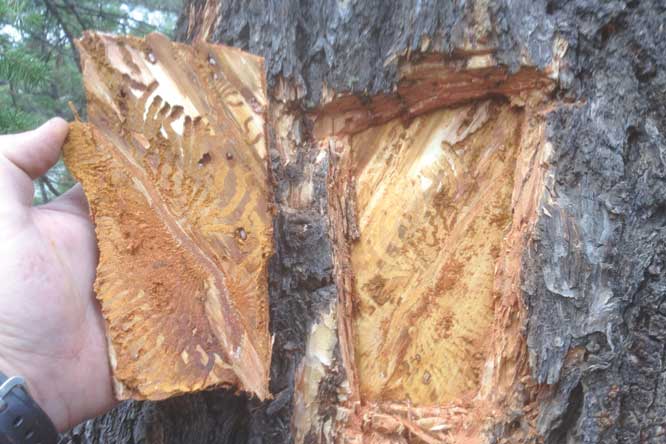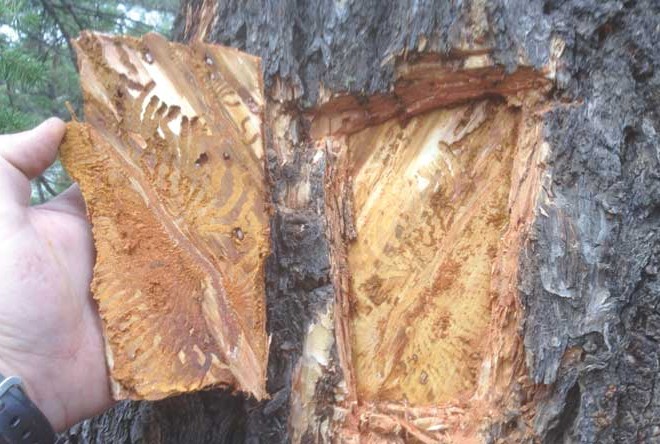A look at managing private lands
By Alissa Johnson
In 2005, Crested Butte resident Jeff Moffett sat in a wood-fired hot tub on his Gold Basin property several miles south of Hartman Rocks Recreation Area. Looking up at the Douglas fir trees surrounding the tub, he noticed a lot of brown needles. The trees appeared to be dying, but determining the cause took some time—one contact suggested lightning as the culprit. “I didn’t buy it,” Moffett said when he showed me around his property.
Known locally for his airline expertise (he has helped shape the local air program through a variety of roles), Moffett also has a background in forestry, including more than five years as a forest planning research assistant for the University of Washington. He believed that something else was at play on his property and ultimately determined that bark beetles had infested the Douglas fir.
Moffett and his wife had purchased the 70-acre property the year before, and old-growth Douglas fir covered much of it. Many homeowners would have been devastated by the news, but Moffett approached the problem with a level of practicality befitting his forestry background.

He started doing research and learned about a state-funded grant program that provided funds for thinning and forest management. After what he calls a crash course in tree thinning, Moffett set about selectively removing trees from his land, getting rid of infested trees and helping the healthy trees thrive. Every year, with continued help from grants, he completed two to three acres.
“When I was actively thinning, I was putting in about 30 to 40 hours a month for seven months, April through October, so two weekends per month,” Moffett explained. His wife, his son, and any friends he could wrangle helped with pruning and piling slash. Sometimes, Moffett used vacation time to “rally for several days straight…. I remember after one stretch, I felt like I did after the Grand Traverse.”
The work paid off. Now, ten years later, as you approach his property from the road, his forest appears lush and green, with no visible indications that the trees have been thinned. On the ground, the forest feels open and spacious, easy to walk through and easy to spot wildlife like grouse running through the trees.
By comparison, neighboring land feels dense, the understory crowded by fallen logs and brush.
Moffett crosses the land with ease, pointing out areas where he cleared the trees or scored fallen logs so they wouldn’t become infested by beetles. And though he has completed most of the thinning, his work is far from complete. Every winter and spring, he pays attention to factors like snowpack and temperatures, gauging the likelihood of a Douglas fir beetle outbreak and scanning the forest for signs of infested trees, like brown needles or reddish-orange frass on the bark—a sort of boring dust left behind by beetles as they burrow into the phloem, the innermost layer of bark where sugars move through the tree. Female beetles lay their eggs there, and when larvae hatch they feed on the phloem and can introduce bacteria.
This spring, Moffett ordered packets of MCH, a naturally occurring pheromone, to staple throughout the forest in a grid pattern. When he opens the back of his Subaru, where the MCH waits to be distributed, a smell similar to moth balls wafts into the air. Once posted, the pheromones will send out a “no vacancy” signal to Douglas fir beetles in the area, helping keep them from infesting the stands on his property.
“My wife calls it my garden,” Moffett says of the land (which he refers to as his forest), and to me, the comparison feels apt.
Of course, not everyone is as willing as Moffett or as educated when it comes to dealing with bark beetles and managing forest. Sam Pankratz is a forester with the Colorado State Forest Service who joined Moffett and me on the tour of Moffett’s land. As the only full-time employee in the Gunnison field office, Pankratz oversees everything from the management of a seedling tree nursery, which distributes 9,000 trees per year, to providing education and technical assistance to private landowners for forest management and fire mitigation. Bark beetles have created a huge demand for his service.
“Every person I talk to is concerned about it,” Pankratz said. But there’s a lot of misinformation—most people think the mountain pine beetle is the biggest problem, when in fact two other beetles are far more prominent in Gunnison County.
The Douglas fir beetle, which Moffett knows so well, is more active at lower elevations and is concentrated on private lands. The spruce beetle is most prevalent at higher elevations, tending to be found in wilderness areas, roadless areas, and national forests. It has caused tree mortality on 1.4 million acres in Colorado since 1996.
“To me, [the spruce beetle] is the big landscape changer now,” Pankratz said. The beetle tends to be concentrated in areas where scale and access are issues, and management rules make mitigation a challenge, if not impossible. Yet the potential death of trees creates the possibility for catastrophic wildfires, and in Pankratz’ eyes, that does more than change the aesthetic of the landscape. It could have significant impacts on factors such as snowpack, melt water runoff and wildlife habitat. (See page 21 for U.S. Forest Service plans to address beetle kill.)
As a forester with the state forest service and not the USFS, Pankratz’ work is concentrated on private lands and helping homeowners mitigate Douglas fir beetle and fire risk (his office manages only a few sections of state lands). And there is no question that the Douglas fir beetle has made its way to the Gunnison Valley.
“It’s rockin’ in Taylor Canyon and over Jack’s Cabin cutoff. The amount of phone calls I’m getting from the Taylor Canyon and Spring Creek this year is exponential,” Pankratz said. He’s also seen beetle activity in Cement Creek, Ohio Creek, Quartz Creek, and Lake Fork of the Gunnison drainages as well as the West Elks. “There’s not a drainage or geographic area within my drainage that I haven’t seen active populations.”
When the beetles move into an area, they tend to cause immediate concern. But according to Pankratz, a region can be vulnerable even before beetle activity is readily apparent.
“Beetles like old, mature trees like we do,” Pankratz explained, noting that there are plenty of old, mature trees around the region. Douglas fir are dependent on a fire regime for regeneration, and a history of fire suppression has left a dense monoculture of big, mature trees. That’s a problem when it comes to beetles because the key to preventing large-scale damage is diversity, both in age and in tree species.
“I encourage folks, at a basic level, to get comfortable with tree identification and a tree’s insect species,” Pankratz said. Insects target specific species as well as age and size classes, which means that knowing how to ward off beetles starts with knowing what beetles you might find. In addition, thinning the forest keeps trees healthier (there’s less competition for resources), and increasing the diversity of trees can help too.
But not all homeowners want to take an active role in forest management. Pankratz has met landowners who purchased their property as a second home and would prefer to sell rather than actively manage the land, and even those who are interested in getting involved are entering unfamiliar territory.
“A lot of people didn’t grow up on the land,” Pankratz says. The idea of landowner as forest manager—both for beetle risk and fire mitigation—is a new concept for many. Still, there are resources available. Pankratz consults with as many people as he can, and homeowners can also apply for grants from the West Region Fire Council to help with things such as fuel reduction.
That kind of grant support made a big difference for Moffett. The $2,000 to $3,000 he received each year helped him do the work and pay off the land in a relatively short amount of time. And for Moffett, the choice to manage his land was simple.
“I just did the calculations and realized this will be the way it is,” he says. He paced himself and kept at it, motivated in part by his enjoyment of the work and in part by his goal. “If the whole hillside turned orange and red, it would be a real bummer.”
Moffett has also begun to help nearby property owners mitigate the risk of beetle infestation. The weekend after we toured his property, he had plans to walk a neighbor’s property with the owner to survey trees and assess the forest health. He has become a spokesperson of sorts for taking an active role in preserving the beauty of your land, and he can champion the results and the connection you develop to your land because he has experienced both first-hand.
Moffett makes it clear: You don’t have to wring your hands and wait for your forest to die. And yet, surrounded by other homeowners and bordering Bureau of Land Management land, it is difficult—even as a visitor—not to feel like Moffett has won a great battle but sits in the middle of a war.
“It feels like a healthy forest,” he says, echoing what I feel, “but to a certain degree I always feel anxious.”
As we drive away from his property, he notes a few trees at the bottom of a hill that are beginning to turn red. He and Pankratz debate whether it might be the result of beetles, a hint of optimism that it might be something else. A few weeks later, Moffett confirms: Douglas fir beetles are at play once again.
For more information on beetle kill, fire mitigation, and forest management resources, visit the Colorado State Forest Service website at http://csfs.colostate.edu/.
 The Crested Butte News Serving the Gunnison Valley since 1999
The Crested Butte News Serving the Gunnison Valley since 1999


